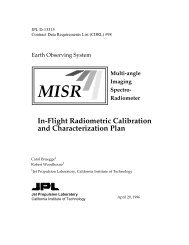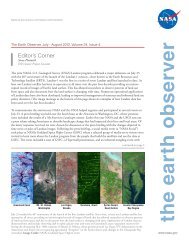AIRS Level 1B Visible/Near-Infrared Channels ATBD - NASA's Earth ...
AIRS Level 1B Visible/Near-Infrared Channels ATBD - NASA's Earth ...
AIRS Level 1B Visible/Near-Infrared Channels ATBD - NASA's Earth ...
You also want an ePaper? Increase the reach of your titles
YUMPU automatically turns print PDFs into web optimized ePapers that Google loves.
<strong>AIRS</strong> <strong>Level</strong> 1b <strong>ATBD</strong> Part 2: Vis/<strong>Near</strong> IR <strong>Channels</strong><br />
7. Appendix B: Response to Reviewer’s Comments<br />
Version 1.1 of this document underwent EOS Project review in March 1997. Comments<br />
were conveyed to the <strong>AIRS</strong> Project in July 1997. Relevant comments are summarized below.<br />
Comments from write-in reviewer Robert Benjamin Lee III:<br />
1) Why isn’t cold space used as a zero-radiance target?<br />
RESPONSE: The blackbody is expected to provide a more uniform target, with less chance<br />
of <strong>Earth</strong> or Moon light contaminating the signal.<br />
2) Because the photodiode’s response varies with temperature, the zero-radiance offset may<br />
be different observing a 308 K blackbody than observing the 255 K typical longwave<br />
radiances of the <strong>Earth</strong>. Will corrections account for this?<br />
RESPONSE: A correction is not necessary because scene temperature does not dominate the<br />
detector temperature and the detector thermal inertia prevents large changes over the 2.7<br />
second scan period. None-the-less, the temperature of the detectors is monitored within each<br />
scan and a correction can be applied should it become necessary.<br />
3) The photodiode response can change with time due to water contamination. What longterm<br />
changes are expected and what corrections will be applied?<br />
RESPONSE: Sections 2.3, 2.4 and 3.0 discuss vicarious calibration, cross calibration, and<br />
spectral calibration algorithms. These approaches are used to correct for aging of all<br />
components of the system.<br />
4) Cross-calibration with MODIS should be described in more detail, especially how the<br />
smaller MODIS spatial response functions will be compared to the larger <strong>AIRS</strong> footprints.<br />
RESPONSE: Cross-calibration is a research product to be refined after launch, and<br />
information on the <strong>AIRS</strong> and MODIS spatial response functions are not yet available. Details<br />
are therefore not available.<br />
Comment from panel reviewer Paul Menzel:<br />
5) High spatial resolution data from <strong>AIRS</strong> Vis/NIR and from MODIS could improve the<br />
<strong>AIRS</strong> cloud-clearing algorithm. Consider this approach, and encourage further collaboration<br />
between <strong>AIRS</strong> and MODIS.<br />
RESPONSE: One of the primary purposes of the <strong>AIRS</strong> Vis/NIR channels is to provide<br />
information on cloud amount (Section 1.2). Initially this information is used for QA<br />
purposes, but as a Research Product Vis/NIR data will be incorporated into the <strong>AIRS</strong><br />
retrieval (see the <strong>Level</strong> 2 <strong>ATBD</strong>). To improve communication with the MODIS Team, <strong>AIRS</strong><br />
has a designated representative to attend MODIS Science Team meetings and develop<br />
familiarity with MODIS retrieval, calibration, and validation activities. Several meetings<br />
10 November 2000 Version 2.2 39







